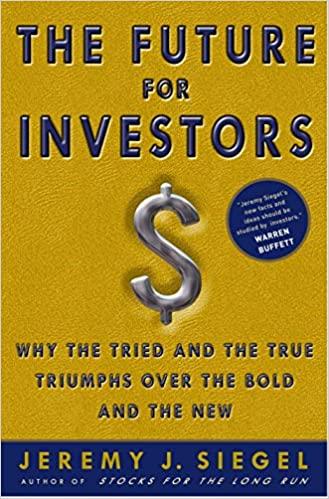Answered step by step
Verified Expert Solution
Question
1 Approved Answer
Please just do 23, 25 and 26 this is problem 15 and the answer for 15 is 15. The probability distribution is: Probability Rate of
Please just do 23, 25 and 26


this is problem 15
and the answer for 15 is
15. The probability distribution is:
Probability Rate of Return
0.7 100%
0.3 ?50
Mean = [0.7 100%] + [0.3 (-50%)] = 55%
Variance = [0.7 (100 ? 55)2] + [0.3 (-50 ? 55)2] = 4725
Standard deviation = 47251/2 = 68.74%
A pension fund manager is considering three mutual funds. The first is a stock fund, the second is a long-term government and corporate bond fund, and the third is a T-bill money market fund that yields a rate of 8%. The probability distribution of the risky funds is as follows: The correlation between the fund returns is 10. What are the investment proportions in the minimum-variance portfolio of the two risky funds, and what is the expected value and standard deviation of its rate of return? Tabulate and draw the investment opportunity set of the two risky funds. Use investment proportions for the stock fund of zero to 100% in increments of 20%. Draw a tangent from the risk free rate to the opportunity set. What does your graph show for the expected rectum and standard deviation of the optimal portfolio? Solve numerically for the proportions of each asset and for the expected return and standard deviation of the optimal risky portfolio. What is the Sharpe ratio of the best feasible CAL? You require that your portfolio yield an expected return of 10%, and that it be efficient, on the best feasible CAL. a. What is the standard deviation of your portfolio? b. What is the portion invested in the T-bill fund and each of the two risky funds? If you were to use only the two risky funds, and still require an expected return of 10%, what would be the investment proportions of your portfolio? Compare its standard deviation to that of the optimized portfolio in problem 9. What do you conclude? Stocks offer an expected rate of return of 18%, with a standard deviation 22%. Gold offers at expected return of 10% with a standard deviation of 30%. a. In light of the apparent inferiority of gold with respect to both mean return and voluntary, would anyone hold gold? If so, demonstrate graphically why one would do so. b. Given the data above, answerer (a) with the additional assumption that the correlation coefficient between gold and stocks equals 1. Draw a graph illustrating why one would or would not hold gold in one's portfolio. Could this set of assumption for expected returns, standard deviations, and correlation represent an equilibrium for the security market? Suppose that there are many stocks in the security market and that the characteristics of stocks A and B are given as follows: Suppose that it is possible to borrow at the risk-free rate, r_j. What mast be the value of the risk-free rate? Assume that expected returns and standard deviation for all securities (including the risk-free rate for borrowing and lending) are known. In this case all investors will have the same optional risky portfolio. The standard deviation of the portfolio is always equal to the weighted average of the standard deviations of the assets in the portfolio. Suppose you have a project that has a 7 chance of doubling your investment in a year and a .3 chance of halving your investment in a year. What is the standard deviation of the rate of return on this investment. Greta, an elderly investor, has a degree of risk aversion of A = 3 when applied to return on wealth over a 3-year horizon. She is pondering two portfolios, the S&P 500 and a hedge fund, as well as a number of 3-year strategies. (All rates are annual, continuously-compounded.) The S&P 500 risk premium is estimated at 5% per year, with a SD of 20%. The hedge fund risk premium is estimated at 10% with a SD of 35%. The return on each of these portfolios in any year is uncorrelated with its return or the return of any other portfolio in any other year. The hedge fund management claims the correlation coefficient between the annual returns on the S&P 500 and the hedge fund in the same year is zero, but Greta believes this is far from certain. Compute the estimated 3-year risk premiums, SDs, and Sharpe ratios for the two portfolios. Assuming the correlation between the annual returns on the two portfolios is indeed zero, what would be the optimal asset allocation? What should be Greta's capital allocation? If the correlation coefficient between annual portfolio returns is 0.3, what is the annual covariance? With correlation of 0.3, what is the covariance between the 3-year returns? Repeat Problem 15 using an annual correlation of 0.3, (If you cannot calculate the 3-year covariance in Problem 17, assume it is 0.05.)Step by Step Solution
There are 3 Steps involved in it
Step: 1

Get Instant Access to Expert-Tailored Solutions
See step-by-step solutions with expert insights and AI powered tools for academic success
Step: 2

Step: 3

Ace Your Homework with AI
Get the answers you need in no time with our AI-driven, step-by-step assistance
Get Started


